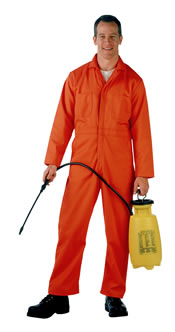
Who Has to Be Trained?
According to EPA’s Worker Protection Standard (WPS), both agricultural workers and pesticide handlers must be trained to recognize the hazards and take proper precautions to prevent exposures.
The regulations define agricultural workers as those who harvest, weed, or water agricultural plants.
Pesticide handlers are defined as those who:
- Mix, load, apply, or transport pesticides;
- Assist with applications, including the incorporation of the pesticide into the soil after application has occurred;
- Act as flaggers;
- Handle equipment that may contain pesticide residues;
- Handle open pesticide containers, or dispose of them;
- Act as crop advisors; or
- Enter a greenhouse after application of pesticides and before the permissible inhalation exposure level has been reached.
Deliver fast and effective Environmental, DOT, and OSHA training with Environmental Training Library. Try it at no cost or risk. For a limited time, also receive a free special report. Download Your Free Report
Pesticide PPE
Any person who performs tasks as a pesticide handler must use the clothing and PPE specified on the labeling for use of the product.
Pesticides, herbicides, and other pest control products vary widely in their toxicity. They can be severely irritating or corrosive to the skin or even cause death. Some are also readily absorbed through intact skin and can represent the major route of exposure.
Many pesticides are handled as powders that can form airborne dust that may be inhaled. Other pest-control products may be sprayed and form mists in the air. Some formulations contain volatile solvents that can evaporate, forming a vapor that may be hazardous above certain airborne concentrations.
The Pesticide Worker Protection Standard permits the optional use of separable glove liners beneath chemical-resistant gloves, unless the pesticide product labeling specifically prohibits their use. Agricultural pilots have the option of wearing chemical-resistant gloves when entering or leaving an aircraft, unless such gloves are required on the pesticide product labeling. If gloves are brought into the aircraft cockpit that has been used to apply pesticides, the gloves must be kept in an enclosed container to prevent contamination.
It is very important to follow the manufacturer’s guidelines regarding the PPE and clothing made of suitable material for use with the specific pesticide. A manufacturer’s or distributer’s failure to include PPE requirements on a pesticide label is a serious violation of federal pesticide laws.
Download your FREE special report, Hazwaste Container Management: Where EPA Inspectors Look First, and receive a 30-day trial of Environmental Training Library at no cost or obligation. Download Your Free Report
General Training Requirements for Handlers and Ag Workers
According to the regulations, training for both agricultural workers and pesticide handlers must include:
- Where and in what form pesticides may be encountered during work activities;
- Hazards of pesticides and health effects of exposure;
- How pesticides can enter the body;
- Symptoms of pesticide exposure;
- Emergency first aid for pesticide poisoning and how to obtain emergency medical care;
- Hazards from chemigation and drift;
- Hazards from pesticide residues on clothing;
- Routine and emergency decontamination procedures, including eye flushing techniques; and
- Warnings about taking pesticides or pesticide containers home.
But those are just the general training requirements. Based on the type of worker, handler or agricultural, there are more specific training requirements. In tomorrow’s Advisor we give you these specifics for the trainer’s, handlers, and agricultural workers.

In the UK, following concern about animal welfare, humane pest control and deterrence is gaining ground through the use of animal psychology rather than destruction. For instance, with the urban Red Fox which territorial behaviour is used against the animal, usually in conjunction with non-injurious chemical repellents. In rural areas of Britain, the use of firearms for pest control is quite common. *^’-